VOS0/ES was the OS for HITAC L-450/470, which was the successor model to and an upper system of HITAC L-330, and it succeeded VOS0. For VOS0/ES, Hitachi improved the functions of the basic system from VOS0, including support for virtual storage of up to 16 megabytes. In addition, with regard to the interactive function adopted for VOS0, Hitachi drastically improved the man-machine interface through interactive job execution using menu guidance, and through Japanese-language support.
Hitachi announced VOS0/ES in January 1983 and started shipping it in October 1983.
VOS0/ES was developed with the aim of increasing efficiency of office operations in each division, reducing development/operation costs, and establishing organic coupling with other systems by being distributed and deployed to each division or each base, such as a plant and a sales office within a company.
Figure 1 shows the user needs for small systems and the objectives for VOS0/ES.
 Figure 1 "User needs for small systems and the objectives for VOS0/ES"
Figure 1 "User needs for small systems and the objectives for VOS0/ES"
VOS0/ES had the following features:
|
Feature
|
Description
|
|
Powerful office automation functions
|
- Capable of processing various types of information including documents, graphs and images
- An office document management system allows distributed processing such as reference to the same document by multiple users, processing on workstations and distribution to other users.
- Business graph processing allows the user to process graphs without creating a program
- Capable of processing handwritten documents/maps, etc. as image data, allowing the user to create I/O slips containing image data.
|
|
Relational database
|
Enables the user to easily define, create, update and search a database from a workstation.
|
|
Easy-to-use interactive processing functions
|
- Menu guidance allows the user to perform business operations.
- Enables the user to interactively create a prompt screen containing a job execution instruction and control information.
|
|
Easy program creation
|
- Achieves development of a small-group system with NHELP languages that can be applied to all clerical processing tasks.
- Efficient program creation in an interactive manner
|
|
Versatile distributed network processing
|
- Establishment of a network to which VOS0/ES is connected as an HNA terminal of VOS1/ES or VOS3.
|
|
Easy and highly flexible system operation
|
- Use of automatic operation mechanism AOP, automatic IPL function and automatic monitoring AOM achieves automation/laborsaving of operation.
|
Figure 2 shows the program configuration for VOS0/ES.



